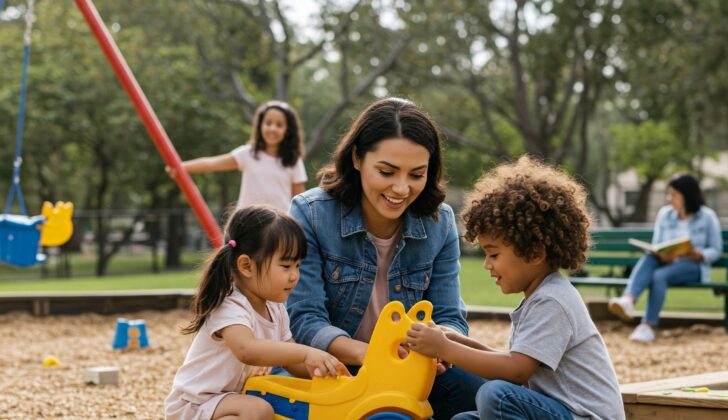Make the most of playground time! This step-by-step guide helps parents encourage language development at the playground. Learn how to build vocabulary, boost social communication, and support your child’s speech development through play.
Why the Playground is a Great Place for Language Learning
The playground is an exciting, interactive environment where children can naturally build their vocabulary, social skills, and communication abilities. Parents can take advantage of language development at the playground by engaging their child in meaningful conversations, modeling language, and encouraging expressive speech while they play.
Step 1: Prepare Before You Go
- Set an Intention – Before heading to the playground, think about what language skills you’d like to focus on. For example:
- Expanding vocabulary (naming equipment, actions, or describing sensations)
- Practicing social language (greeting others, taking turns, making requests)
- Encouraging full sentences and expressive language
- Dress for Interaction – Avoid distractions like being on the phone and wear comfortable clothing so you can actively participate in play.
Step 2: Describe and Label Objects and Actions They Are Interested In
Once at the playground, help your child build vocabulary by labeling objects, actions, and emotions.
How to Do It:
- Label Playground Equipment:
- “Look, this is a slide! The slide is very tall.”
- “This is a swing. The swing moves back and forth.” “The swing is going fast!”
- Describe Actions:
- “You’re climbing up the ladder.”
- “You’re jumping so high!”
- Describe Feelings and Sensations:
- “The slide feels smooth and slippery.”
- “You’re smiling! You look happy!”
📝 Tip: Use a mix of simple and slightly advanced words. For example, say “big” but also introduce “gigantic” or “enormous” while you are interacting with something large.
Step 3: Ask Open-Ended Questions
Encourage conversation by asking open-ended questions that require more than just “yes” or “no” answers.
How to Do It:
- Instead of “Did you have fun?”, ask “What was your favorite thing to do today?”
- Instead of “Do you like the swings?”, ask “How does it feel when you’re swinging high?”
- Instead of “Are you climbing?”, ask “Where do you think this ladder leads?”
📝 Tip: If your child gives short answers, model a longer response to show them how to elaborate.
Example:
Child: “Swing fun.”
Parent: “Yes! The swing is fun! You can go high and low. Do you like going fast or slow?”
Step 4: Encourage Storytelling and Imagination
Playgrounds are the perfect place for pretend play, which builds storytelling and creative language skills.
How to Do It:
- Turn the Playground into an Adventure:
- “Let’s pretend this slide is a waterfall! We have to climb up the mountain first.”
- “This jungle gym is a spaceship. Where should we fly today?”
- Encourage Your Child to Narrate Their Play:
- “Tell me what’s happening in your adventure!”
- “What do you see from the top of the tower?”
📝 Tip: Follow your child’s lead. If they pretend they’re a pirate, go along with it and add to the story.
Step 5: Model and Expand Sentences
Help your child develop longer sentences by expanding on what they say.
How to Do It:
- If your child says: “Swing fast!”
- You can say: “Yes! You are swinging so fast! The wind is blowing in your hair!”
- If your child says: “Big slide.”
- You can say: “That is a big, red slide. Let’s go down together!”
📝 Tip: Repeating and expanding sentences helps your child learn sentence structure naturally.
Step 6: Encourage Social Language with Other Kids
Social interactions help children learn conversation skills, turn-taking, and cooperation.
How to Do It:
- Teach Greetings:
- “Let’s say ‘Hi’ to the other kids!”
- Model Sharing Language:
- “Can you ask, ‘Can I have a turn on the slide?'”
- “Say, ‘Let’s play together!'”
- Encourage Problem-Solving Words:
- “If you want to use the swing, you can say, ‘Can I have a turn when you’re done?'”
📝 Tip: If your child is shy, model the language for them first and gently encourage them to try.
Step 7: Sing Songs and Play Word Games
Songs and word games make learning fun and reinforce language skills.
How to Do It:
- Sing Playground-Related Songs:
- “The Wheels on the Bus” while pretending to drive
- “Row, Row, Row Your Boat” while sitting on a seesaw
- Play “I Spy”:
- “I spy something yellow. Can you find it?”
- Rhyming Game:
- “Can you think of a word that rhymes with ‘slide’?”
📝 Tip: Use gestures and exaggerated expressions to keep your child engaged.
Step 8: Reflect and Recap Before Leaving
Before heading home, talk about the experience to reinforce language learning.
How to Do It:
- Ask About Their Favorite Part:
- “What was the best thing you did today?”
- Summarize the Day:
- “We went on the swings, climbed the jungle gym, and slid down the slide. We had so much fun!”
- Introduce New Words Again:
- “Remember when you were balancing on the beam? That means you were standing very still and careful!”
📝 Tip: Use car rides or walks home to have these conversations while the experience is fresh.
Final Thoughts
Encouraging language development at the playground is about being intentional, engaging, and interactive. The key is to talk with—not just to—your child, ask questions, and follow their interests while expanding their vocabulary and social skills. By making playground visits rich with language, you’ll be helping your child develop strong communication skills while having fun together!
for further reading visit:
MDS: Is My Child’s Language on Track? A Speech-Language Pathologist’s Guide for Parents
MDS: Understanding Speech Therapy: A Parent and Caregiver’s Guide to Communication Support











